Bagadates on:
[Wikipedia]
[Google]
[Amazon]
Baydad (also spelled Bagdates), was a dynast ('' frataraka'') of Persis from 164 to 146 BC.
 Since the end of the 3rd or the beginning of the 2nd century BCE, Persis had been ruled by local dynasts subject to the
Since the end of the 3rd or the beginning of the 2nd century BCE, Persis had been ruled by local dynasts subject to the
Background
 Since the end of the 3rd or the beginning of the 2nd century BCE, Persis had been ruled by local dynasts subject to the
Since the end of the 3rd or the beginning of the 2nd century BCE, Persis had been ruled by local dynasts subject to the Seleucid Empire
The Seleucid Empire (; grc, Βασιλεία τῶν Σελευκιδῶν, ''Basileía tōn Seleukidōn'') was a Greek state in West Asia that existed during the Hellenistic period from 312 BC to 63 BC. The Seleucid Empire was founded by the ...
. They held the ancient Persian title of '' frataraka'' ("leader, governor, forerunner"), which is also attested in the Achaemenid
The Achaemenid Empire or Achaemenian Empire (; peo, wikt:𐎧𐏁𐏂𐎶, 𐎧𐏁𐏂, , ), also called the First Persian Empire, was an History of Iran#Classical antiquity, ancient Iranian empire founded by Cyrus the Great in 550 BC. Bas ...
-era. The Achaemenid Empire, which had a century earlier ruled most of the Near East
The ''Near East''; he, המזרח הקרוב; arc, ܕܢܚܐ ܩܪܒ; fa, خاور نزدیک, Xāvar-e nazdik; tr, Yakın Doğu is a geographical term which roughly encompasses a transcontinental region in Western Asia, that was once the hist ...
, originated from the region. The ''frataraka'' themselves emphasized their close affiliation with the prominent Achaemenid King of Kings
King of Kings; grc-gre, Βασιλεὺς Βασιλέων, Basileùs Basiléōn; hy, արքայից արքա, ark'ayits ark'a; sa, महाराजाधिराज, Mahārājadhirāja; ka, მეფეთ მეფე, ''Mepet mepe'' ...
, and their court was probably at the former Achaemenid capital of Persepolis, where they financed construction projects on and near the Achaemenid plateau. The ''frataraka'' had traditionally been regarded as priestly dynasts or advocates of religious (and political) opposition to Hellenism, however, this is no longer considered the case.
Chronology of the ''frataraka''
The traditional view of the chronology of the frataraka dynasts was originally; Baydad,Ardakhshir I
Ardakhshir I (also spelled Artaxerxes I; Aramaic: ''rtḥštry'') was a dynast (''frataraka'') of Persis in the late 3rd-century BC, ruling sometime after 220 to .
Name
''Ardakhshir'' (''Ardashir'') is the Middle Persian form of the Old Persian ...
, Wahbarz, Wadfradad I and Wadfradad II
Wadfradad II (also spelled Autophradates II) was a dynast (''frataraka'') of Persis in the late 2nd-century BC, ruling sometime after 138 BC. He was appointed as ''frataraka'' by the Parthian king Mithridates I (), who granted him more autonomy, ...
. However, recent findings of Persis coins have led to more a likely chronology; Ardakhshir I, Wahbarz, Wadfradad I, Baydad and Wadfradad II.
Rule
On the reverse of his coins, Bagadates is depicted standing in front of a Zoroastrian fire-altar, or seated in majesty holding a staff of authority and possibly a pomegranate in his left hand (''illustration, left''). In his coinage, Bagadates has his portrait on the obverse, wearing the satrapal headdress and the Hellenistic diadem. On the reverse, he is either shown enthroned, or making his devotions to a fire temple. The weight standard of the coins is the Attic standard, and the tetradrachm is the usual coin size, as was the usual case in the Seleucid empire. The coins are inscribed in Aramaic with the name of the ruler.References
Sources
* . * * * * * * {{Fratarakas of Persis Seleucid satraps 2nd-century BC rulers in Asia 2nd-century BC Iranian people Zoroastrian rulers Frataraka rulers of Persis